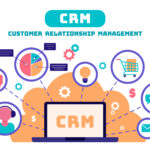In today’s highly competitive digital landscape, businesses can’t afford to lose track of potential customers. Whether you run a startup or a growing enterprise, managing your leads effectively can make the difference between thriving and simply surviving.
This is where lead management comes into play.
In this in-depth guide, we’ll break down everything you need to know about lead management—what it is, why it matters, how to implement it, the best tools available, and proven strategies to streamline your sales pipeline. Whether you’re new to digital marketing or a seasoned professional looking to optimize your sales process, this post will arm you with actionable insights and expert tips.
Table of Contents
What Is Lead Management?
Lead management is the process of capturing, tracking, and nurturing potential customers (leads) through various stages of the sales funnel until they become paying customers. This structured approach ensures that no opportunity slips through the cracks and that your sales and marketing teams are aligned.
A “lead” is any individual or organization that shows interest in your products or services. This interest can come through a variety of channels—such as a website form, social media interaction, ad click, or email inquiry.
Lead management typically includes the following components:
-
Lead qualification
Why Is Lead Management Important?
Here are just a few reasons why businesses must prioritize lead management in 2025 and beyond:
-
Maximizes ROI: Every lead costs time or money to acquire. Managing them effectively ensures a higher conversion rate.
-
Shortens Sales Cycles: Structured communication leads to faster decision-making and fewer drop-offs.
-
Improves Sales & Marketing Alignment: Keeps both departments informed, aligned, and focused on the same goals.
-
Enhances Customer Experience: Timely, relevant communication builds trust and improves satisfaction.
-
Increases Revenue: The more leads you convert, the more revenue your business generates.
According to a report by Forrester Research, companies that excel at lead nurturing generate 50% more sales-ready leads at a 33% lower cost.
The Key Stages of Lead Management
Let’s break down the essential stages of lead management, step by step:
1. Lead Generation
This is the process of attracting potential customers. Common methods include:
-
PPC advertising
-
Social media campaigns
-
Webinars and live events
2. Lead Capture
Once a user expresses interest (e.g., downloads an ebook, fills a form), you capture their information using:
-
Landing pages
-
Pop-ups
-
Chatbots
-
Forms integrated with CRM tools
3. Lead Qualification
Not all leads are created equal. Some may be ready to buy, while others are just browsing. Use qualification criteria like:
-
Budget
-
Authority
-
Need
-
Timeline (BANT model)
4. Lead Nurturing
This involves building a relationship with your leads via:
-
Email sequences
-
Personalized follow-ups
-
Targeted content
5. Lead Distribution
Assigning leads to the right sales reps based on geography, industry, or product interest ensures better handling.
6. Lead Conversion
Once a lead is sales-qualified, your team moves them toward a sale through calls, demos, or proposals.
Lead Management vs. Customer Relationship Management (CRM)
While these terms are often used interchangeably, they’re not quite the same.
| Lead Management | CRM (Customer Relationship Management) |
|---|---|
| Focuses on pre-sale activities | Focuses on post-sale relationships |
| Captures and nurtures leads | Manages customer interactions |
| Usually handled by marketing/sales | Used across marketing, sales, and support |
| Ends at conversion | Begins at conversion |
Many modern CRM systems like HubSpot, Zoho, and Salesforce combine both lead management and customer relationship features.
Benefits of a Lead Management System
Implementing a robust lead management system provides several advantages:
-
Centralized data: Access all lead info in one place.
-
Lead scoring: Rank leads based on interest and behavior.
-
Automation: Automate repetitive tasks like email follow-ups and lead assignment.
-
Analytics: Track KPIs such as conversion rate, lead source performance, etc.
-
Personalization: Customize messaging based on lead behavior and profile.
Top Lead Management Tools for 2025
Here’s a look at some of the top-rated lead management software to consider:
1. HubSpot
A leader in inbound marketing, HubSpot offers a complete CRM and lead management solution. Best for small to mid-sized businesses.
2. Salesforce Sales Cloud
Ideal for enterprise-level businesses. Offers deep analytics, AI integration, and customizable dashboards.
3. Zoho CRM
Affordable and feature-rich, Zoho is popular among SMBs for its automation capabilities.
4. Pipedrive
Simple, visual pipeline management tool perfect for sales teams that value clarity and automation.
5. Freshsales
Powered by AI, this tool offers lead scoring, email tracking, and built-in phone systems.
You can explore detailed reviews of these tools at G2 or Capterra.
How to Build a Lead Management Process
Here’s a step-by-step process to create a lead management system that actually works:
Step 1: Define Your Ideal Customer
Create buyer personas to understand who your leads should be.
Step 2: Choose the Right Tools
Select a lead management software that aligns with your business size and goals.
Step 3: Build Lead Capture Forms
Make it easy for visitors to share their contact details in exchange for value.
Step 4: Qualify and Score Leads
Use behavioral and demographic data to prioritize leads.
Step 5: Set Up Nurture Campaigns
Use email automation, remarketing, and retargeting to stay in touch.
Step 6: Monitor and Optimize
Regularly analyze performance metrics and improve your strategies.
Common Lead Management Mistakes to Avoid
Avoid these pitfalls to ensure your efforts don’t go to waste:
-
Ignoring cold leads: Even less responsive leads can convert with the right nurturing.
-
Lack of automation: Manual processes slow down response times.
-
Not segmenting leads: Generic messages fail to engage.
-
No clear handoff to sales: Marketing-to-sales transition must be smooth.
-
Failing to follow up: A quick follow-up can dramatically increase conversion rates.
Lead Scoring: Prioritizing High-Quality Leads
Lead scoring is a technique used to assign value to each lead based on their behavior and characteristics. Higher scores indicate higher likelihood to convert.
Common scoring metrics include:
-
Pages visited
-
Email opens
-
Click-through rates
-
Demographics
-
Downloaded resources
Tools like HubSpot, Salesforce, and Marketo offer automated lead scoring to help you focus on leads that matter.
Lead Management Best Practices
Here are some expert-approved strategies to take your lead management game to the next level:
-
Segment your audience based on interests and behavior.
-
Use lead magnets like ebooks and webinars to capture interest.
-
Personalize your communication to build stronger connections.
-
A/B test your emails and landing pages for higher engagement.
-
Leverage automation to save time and improve consistency.
-
Track every interaction with a CRM to maintain context.
-
Use chatbots for real-time lead qualification on your website.
-
Implement a lead nurturing workflow to convert cold leads over time.
Conclusion
Lead management is no longer optional—it’s a must for any business aiming to grow in today’s digital-first world. From capturing interest to nurturing prospects and closing deals, a well-structured lead management system can dramatically increase your conversion rates, customer satisfaction, and bottom line.
By investing in the right tools, avoiding common mistakes, and following best practices, you’ll not only streamline your sales process but also gain a competitive edge in your industry.














